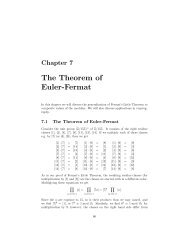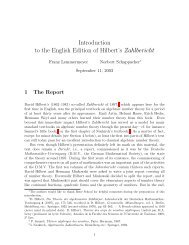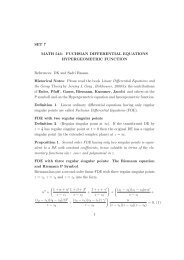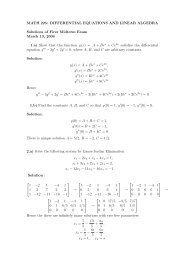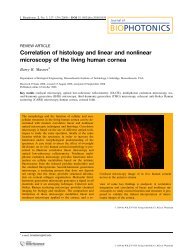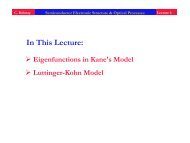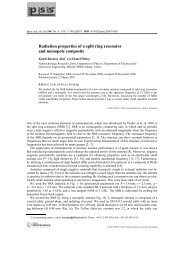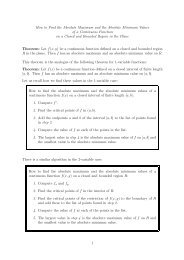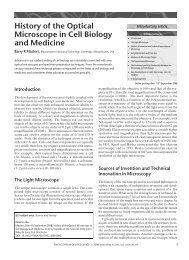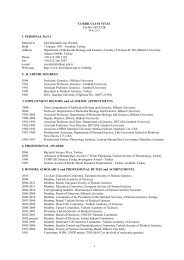Jump processes in surface diffusion - Bilkent University - Faculty of ...
Jump processes in surface diffusion - Bilkent University - Faculty of ...
Jump processes in surface diffusion - Bilkent University - Faculty of ...
Create successful ePaper yourself
Turn your PDF publications into a flip-book with our unique Google optimized e-Paper software.
50 G. Antczak, G. Ehrlich / Surface Science Reports 62 (2007) 39–61<br />
Fig. 30. Temperature dependence <strong>of</strong> length <strong>of</strong> correlated jumps <strong>in</strong> <strong>diffusion</strong> <strong>of</strong><br />
adatom on Lennard-Jones fcc(100) <strong>surface</strong> [107].<br />
Fig. 32. Adatom trajectories on bcc(110) plane modelled with Price<br />
potential [42,43] dur<strong>in</strong>g 200 ps at ∼0.4T m [41]. (a) S<strong>in</strong>gle jumps. (b) Double<br />
jumps. (c) Complicated trajectories.<br />
3. Long and rebound jumps<br />
3.1. Theoretical work<br />
Fig. 31. Adatom trajectories on Lennard-Jones (100) <strong>surface</strong> at T = 0.34T m ,<br />
reveal<strong>in</strong>g non-nearest neighbour transitions [11].<br />
The study by Evangelakis and Papanicolaou [82] has been<br />
the most detailed work on multiple exchange events, but<br />
these <strong>processes</strong> were rediscovered several years later by Xiao<br />
et al. [105,106]. Us<strong>in</strong>g EAM potentials they found multiple<br />
atom exchange events for stra<strong>in</strong>ed Cu(100) and Pt(100), which<br />
were designated as crowdions.<br />
Although as yet there are no experiments to demonstrate<br />
such large scale exchange <strong>processes</strong>, there is little doubt that<br />
they will be found at elevated temperatures. However, detailed<br />
theoretical studies <strong>of</strong> such complicated <strong>processes</strong> will have<br />
to wait until procedures for <strong>in</strong>vestigat<strong>in</strong>g simple exchanges<br />
become reliable. One th<strong>in</strong>g is certa<strong>in</strong>: much more extended<br />
cell sizes will be needed for such calculations. From the<br />
experimental po<strong>in</strong>t <strong>of</strong> view, STM should be the most suitable<br />
tool to uncover such transitions.<br />
The view that <strong>in</strong> <strong>diffusion</strong> over a <strong>surface</strong>, atoms jump at<br />
random between nearest-neighbor sites, rema<strong>in</strong>ed widespread<br />
until the end <strong>of</strong> the seventies. At that time a number <strong>of</strong><br />
simulations appeared which suggested a more complicated<br />
picture <strong>of</strong> atomic events. Tully et al. [107] <strong>in</strong> 1979 carried out<br />
ghost particle simulations for a (100) <strong>surface</strong> <strong>of</strong> a Lennard-<br />
Jones crystal at different temperatures below the melt<strong>in</strong>g po<strong>in</strong>t<br />
T m . They discovered that, as shown <strong>in</strong> Fig. 30, the average<br />
jump length more than doubled as the temperature <strong>in</strong>creased<br />
from 0.2T m to 0.6T m . More extensive molecular dynamics were<br />
carried out at much the same time by DeLorenzi et al. [10,11],<br />
aga<strong>in</strong> on an fcc Lennard-Jones crystal. Most <strong>in</strong>terest<strong>in</strong>g was<br />
the fact that on the (100) plane at ∼0.3T m long jumps were<br />
observed, between sites as much as three to four spac<strong>in</strong>gs apart.<br />
This is clear from the atom trajectories <strong>in</strong> Fig. 31.<br />
Corrections to <strong>diffusion</strong> rates predicted by transition-state<br />
theory for Rh(100) stemm<strong>in</strong>g from transitions to sites farther<br />
away than a nearest-neighbour distance were done by Voter<br />
and Doll [108], aga<strong>in</strong> with Lennard-Jones <strong>in</strong>teractions. Only<br />
<strong>in</strong> the vic<strong>in</strong>ity <strong>of</strong> 1000 K were jumps to other than nearestneighbour<br />
positions found. In the same year, 1985, DeLorenzi<br />
and Jacucci [41] published molecular dynamics simulation<br />
on various bcc <strong>surface</strong>s modelled with a metallic potential<br />
developed by Price [42,43] for sodium. On the most densely<br />
packed <strong>surface</strong>, the (110), at a temperature <strong>of</strong> 0.4T m , they<br />
found not only jumps between nearest-neighbour sites, as <strong>in</strong><br />
Fig. 32(a), but also double and more elaborate transitions,<br />
shown <strong>in</strong> Fig. 32(b) and (c). Evangelakis and Papanicolaou [82]<br />
also saw that double jumps started to be active on the (100)<br />
plane <strong>of</strong> copper, an fcc metal, at temperatures above 750 K.<br />
Above 800 K, more complicated <strong>processes</strong>, such as quadruple<br />
exchange began play<strong>in</strong>g a role as well.



